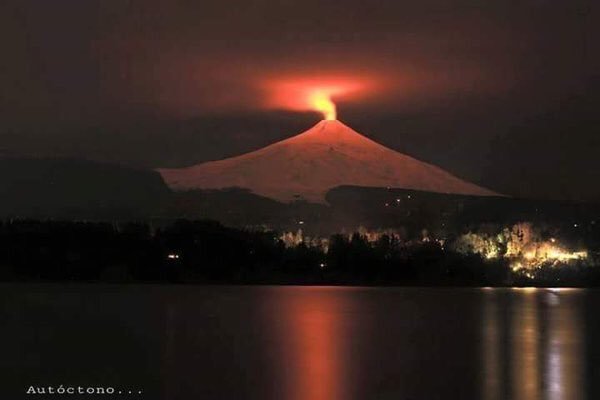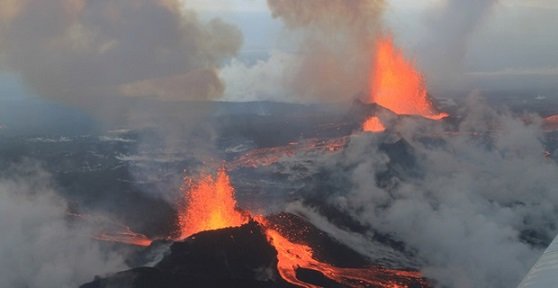Selvfølgelig er de ting vi har set på det sidste del af en meget mere omfattende langvarig tendens. Seismisk aktivitet synes at have blevet forstærket over de sidste tiår, og nu synes ting for alvor at accelerere. Følgende er hvordan én nyhedskilde for nyligt opsummerede hvad vi har bevidnet...
Hvis det synes at jordskælv og vulkanudbrud sker mere hyppigt, er det fordi de gør. Hvis vi ser på den globale forekomst af størrelsesorden seks (M6) eller større fra 1980 til 1989 var der et gennemsnit af 108.5 jordskælv per år, fra 2000 til 2009 har planeten ligget på et gennemsnit på 160.9 jordkælv per år: det er en forøgelse på 38.9% af M6+ jordskælv i de senere år. Urolighed synes også at være i vækst blandt verdens supervulkaner. Island (der huser nogle af de farligst vulkaner på planeten), Santorini i Grækenland, Uturuncu i Bolivien, Yellowstone og Long Valley calderaerne i U.S.A, Laguna del Maule i Chile, Italiens Campi Flegrei - næsten alle verdens aktive supervulkanske systemer udviser en eller anden slags inflation, en tidlig indikation på at tryk opbygges i disse vulkansystemer.Men selvfølgelig vil de fleste amerikanere være fuldstændig ligeglade, indtil det begynder at påvirke dem personligt.
Kommentar: Det samme gælder selvfølgelig også de fleste danskere, der seismisk og klimatologisk for tiden har det rimeligt nok til ikke at bryde sig om tegnene fra omverdenen der peger hen imod globale geologiske/ klimatiske omvæltninger.
Artiklen, 40 volcanoes are erupting right now with 34 of them along The Ring Of Fire er ikke videre oversat til dansk.
Well, perhaps they should start paying attention to the warning signs. In recent weeks we have seen significant earthquakes in Michigan, Texas, Mississippi, California, Idaho And Washington. In addition, it is being reported that pressure is building in dormant volcanoes in Arizona and California. Just because we have not had a killer earthquake or a large volcanic eruption in the U.S. in recent years does not mean that it will always be that way. Right now the entire planet appears to be waking up, and this especially seems to be true of the Ring of Fire.
If you are not familiar with the Ring of Fire, just imagine a giant ring that runs around the outer perimeter of the Pacific Ocean. Approximately 90 percent of all earthquakes and approximately 75 percent of all volcanic eruptions occur within this area, and the entire west coast of North America is considered to be part of the Ring of Fire.
For so long, the west coast has been incredibly blessed not to have experienced a major seismic event. But scientists tell us that it is only a matter of time.
And right now, just about every other part of the Ring of Fire is shaking violently.
For example, a magnitude 6.8 earthquake just hit Japan on Wednesday...
A magnitude-6.8 earthquake that shook northeast Japan on Wednesday was an aftershock of the devastating 2011 quake that triggered a massive tsunami and nuclear power plant meltdown.
"We consider this morning's earthquake to be an aftershock of the 2011 Northeastern Pacific Earthquake," said Yohei Hasegawa, an official at the Japanese meteorological agency.
The temblor, which struck just after 6 a.m. local time (5 p.m. ET Tuesday), was sparked by the Pacific tectonic plate "subducting," or moving under, the main land plate, he added.
Hasegawa warned that more tremors may be on the way.
One Japanese expert is warning that Japan "might have entered an era of great earthquakes and volcanic eruptions", and considering the immense devastation that the great earthquake and tsunami of 2011 caused, that is a very sobering assessment.
Meanwhile, a series of very strong earthquakes have struck Papua New Guinea recently as well. The following comes from the Washington Post...
A powerful earthquake rattled Papua New Guinea on Thursday, the fourth strong quake to hit the South Pacific island nation in a week. The temblor prompted officials to issue a local tsunami warning, but it was lifted shortly afterward with no reports of damage.Once again, just because things have always been a certain way does not mean that they will always be that way.
The 7.1-magnitude quake struck about 150 kilometers (94 miles) southwest of the town of Panguna on Bougainville Island at a depth of 23 kilometers (14 miles), the U.S. Geological Survey reported.
As Americans, we are not accustomed to being concerned about major earthquakes and massive volcanic eruptions, but that could soon change in a big way.
The truth is that our planet and our sun are changing in ways that are unpredictable and that our scientists don't completely understand.
For example, a recent LiveScience article discussed the fact that scientists are deeply puzzled by the fact that the magnetic field of our planet is getting weaker 10 times faster than previously believed...
Scientists already know that magnetic north shifts. Once every few hundred thousand years the magnetic poles flip so that a compass would point south instead of north. While changes in magnetic field strength are part of this normal flipping cycle, data from Swarm have shown the field is starting to weaken faster than in the past. Previously, researchers estimated the field was weakening about 5 percent per century, but the new data revealed the field is actually weakening at 5 percent per decade, or 10 times faster than thought. As such, rather than the full flip occurring in about 2,000 years, as was predicted, the new data suggest it could happen sooner.
And in a previous article, I discussed how one scientist has discovered that activity on the sun is declining at a faster pace "than at any time in the last 9300 years" right now.
I don't pretend to have all the answers for why these things are happening, but clearly some very unusual things are taking place.
So what do you think?
Do you believe that you know why our planet and our sun are experiencing such dramatic changes?





Læserkommentarer
dig vores Nyhedsbrev